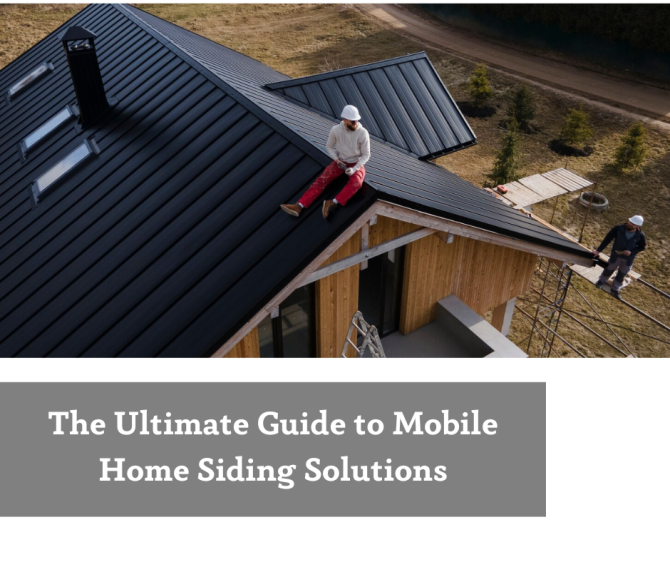Siding is a protective material attached to the exterior of a house or other similar structure, such as a multifamily dwelling. On a house, siding is what helps defend the exterior against weather, impacts, and other intrusive elements, such as insects.

The Ultimate Guide to Mobile Home Siding Solutions
In addition to adding to the aesthetic appeal of your home, mobile home siding guards against mold, physical damage, reduces pollution to the environment, and raises the value of your property. Worse yet, the majority of siding companies offer you poor-quality products. Finding siding resistant to rust, insects, severe weather, and dents must therefore be your top priority. Fortunately, enough information in this guide will help you understand more clearly. So continue reading.
Understanding Siding In Construction
Siding is a protective material attached to the exterior of a house or other similar structure, such as a multifamily dwelling. On a house, siding is what helps defend the exterior against weather, impacts, and other intrusive elements, such as insects. It also adds curb appeal and can help homeowners express their home style through the many materials, textures, and colors of varying types of siding.
Why Is Siding For Mobile Homes Important?
Installing mobile home siding is an excellent way to increase the value of your home, update its appearance, and make it more energy-efficient. Siding is an excellent investment for both old and new homes. Here are some reasons to consider:
1. Enhanced Aesthetic Appeal
- Fresh siding can dramatically improve the appearance of your mobile home, giving it a modern and well-maintained look.
- A variety of styles, colors, and textures are available to match your taste and the overall look of your neighborhood.
2. Increased Energy Efficiency
- Insulated siding options can improve your home's thermal efficiency, reducing heating and cooling costs.
- Proper siding can prevent air leaks and maintain a more consistent indoor temperature.
3. Improved Durability and Protection
- High-quality siding protects your home from harsh weather conditions such as rain, wind, and snow.
- It can prevent damage from pests, mold, and mildew, which can compromise the structural integrity of your home.
4. Low Maintenance
- Modern siding materials require minimal upkeep compared to traditional wood siding, which needs regular painting and sealing.
- Materials like vinyl or fiber cement are resistant to rot, rust, and insect damage.
5. Increased Home Value
- New siding can increase your mobile home's market value and curb appeal, making it more attractive to potential buyers.
- It’s a worthwhile investment that can yield a good return if you decide to sell your home.
What is Siding Made Of?
Understanding the materials and siding types that are available is a great place to start when determining which type of siding is best for you, as each of the most popular types has advantages and disadvantages of its own. There are numerous materials to choose from, including vinyl, wood, fiber cement, stone, and aluminum.
Types Of Mobile Home Siding
As discussed, there are various types of mobile home siding that people use depending on their preferences and needs. Here are the most common types of mobile home sidings used in construction:
1. Vinyl
For good reason, vinyl siding has grown to be one of the most popular siding choices for both single-family and mobile homes. There are hundreds of colors to choose from, as well as insulated and non-insulated styles available for this siding option. It is also an inexpensive choice that has a high market value.
2. Wood
Due to its warm and rustic appearance, wood siding is a popular choice among homeowners. Siding made of wood is available in several varieties. Plywood, or T1-11, is a 4 x 8-foot grooved panel that can be put on a mobile home either vertically or horizontally. In comparison to other wood types, cedar siding is more moisture-resistant, more rustic-looking, and readily available. However, because wood siding is more likely to rot and decay, it requires more maintenance.
3. Fiber Cement
Fiber cement siding is more expensive than other mobile home siding materials, but it comes with a long list of advantages. It comes in many sizes and thicknesses, as well as the ability to mimic the appearance of other types of siding on the market, which is a big plus. Fiber cement siding won’t rot, is extremely durable, and most manufacturers provide extended warranties against fade, color reduction, and finish. Although installation is more difficult, it can be done both vertically and horizontally.
4. Stone
The main benefits of stone, whether it's natural or artificial, are its attractive appearance and low energy consumption. However, because of its weight and labor-intensive installation, it is difficult to do yourself and costly to have done by a professional.
5. Aluminum
Aluminum is inexpensive, lightweight, and relatively simple to install. It can also be painted and is a tried-and-true siding option on mobile homes because it has been used successfully for years. A drawback to consider with aluminum siding is that it can dent.
Mobile Home Siding Installation
As you well know, home siding is only viable for replacement when it becomes unattractive. However, you must follow the following steps during installation to realize the best results.
-
Prepare the working area: First, you must declutter the wall of existing siding and caulk. Secondly, you should remove peripheral installations like light bulbs and gutters to create more room for renovation. Finally, mobile home siding experts recommend that you add an extra layer of insulation on your work area. It will make the house energy efficient once residing is complete. Anyhow, you must consult them first to avoid compatibility issues.
-
Install the corner post: Next, you need to update the look of your home using corner posts. However, before doing that, you must measure and cut a half-inch gap between the roof and the topmost part of the pole. Lastly, you should anchor the post using nails after every foot.
-
Trace a chalk line: Do you want to achieve uniformity? Then trace a straight line along the length of the mobile home. Doing so will help you install wall cladding fast. Finally, you can install the starter strip and nail the sidings on the wall. Anyhow, leave a one-quarter gap between each subsequent panel to hide the cuts away.
-
Trim flashing: Lastly, install trim pieces around the doors and windows. However, ensure you use a mitersaw to gain the best results. Above all, keep the trims wider than the window to promote form, function, and aesthetics.
FAQ
Where to Get the Best Siding For Mobile Homes?
Let us help you make the best siding purchase decisions for your manufactured home, to get the best value for your money.
How Often Should I Replace Mobile Home Siding?
The life expectancy of your mobile home’s siding depends on the material it's made of, as well as the climate in your area. In general, you’ll want to replace vinyl siding every 10-20 years.
More durable materials, such as aluminum or fiber cement, can last anywhere between 20-50 years. No matter the material or climate, be sure to check your siding frequently for cracks, warping, or missing sections and replace it accordingly.

